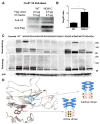Unpaired Extracellular Cysteine Mutations of CSF3R Mediate Gain or Loss of Function
- PMID: 28652245
- PMCID: PMC5763920
- DOI: 10.1158/0008-5472.CAN-17-1052
Unpaired Extracellular Cysteine Mutations of CSF3R Mediate Gain or Loss of Function
Abstract
Exclusive of membrane-proximal mutations seen commonly in chronic neutrophilic leukemia (e.g., T618I), functionally defective mutations in the extracellular domain of the G-CSF receptor (CSF3R) have been reported only in severe congenital and idiopathic neutropenia patients. Here, we describe the first activating mutation in the fibronectin-like type III domain of the extracellular region of CSF3R (W341C) in a leukemia patient. This mutation transformed cells via cysteine-mediated intermolecular disulfide bonds, leading to receptor dimerization. Interestingly, a CSF3R cytoplasmic truncation mutation (W791X) found on the same allele as the extracellular mutation and the expansion of the compound mutation was associated with increased leukocytosis and disease progression of the patient. Notably, the primary patient sample and cells transformed by W341C and W341C/W791X exhibited sensitivity to JAK inhibitors. We further showed that disruption of original cysteine pairs in the CSF3R extracellular domain resulted in either gain- or loss-of-function changes, part of which was attributable to cysteine-mediated dimer formation. This, therefore, represents the first characterization of unpaired cysteines that mediate both gain- and loss-of-function phenotypes. Overall, our results show the structural and functional importance of conserved extracellular cysteine pairs in CSF3R and suggest the necessity for broader screening of CSF3R extracellular domain in leukemia patients. Cancer Res; 77(16); 4258-67. ©2017 AACR.
©2017 American Association for Cancer Research.
Conflict of interest statement
J.W. Tyner reports receiving commercial research grants from Agios, Aptose, Array, AstraZeneca, Constellation, Genentech, Incyte, Janssen, Seattle Genetics, Syros, and Takeda and is a consultant/advisory board member for Leap Oncology. No potential conflicts of interest were disclosed by the other authors.
Figures





Similar articles
-
The Colony-Stimulating Factor 3 Receptor T640N Mutation Is Oncogenic, Sensitive to JAK Inhibition, and Mimics T618I.Clin Cancer Res. 2016 Feb 1;22(3):757-64. doi: 10.1158/1078-0432.CCR-14-3100. Epub 2015 Oct 16. Clin Cancer Res. 2016. PMID: 26475333 Free PMC article.
-
Ligand independence of the T618I mutation in the colony-stimulating factor 3 receptor (CSF3R) protein results from loss of O-linked glycosylation and increased receptor dimerization.J Biol Chem. 2014 Feb 28;289(9):5820-7. doi: 10.1074/jbc.M113.508440. Epub 2014 Jan 8. J Biol Chem. 2014. PMID: 24403076 Free PMC article.
-
Role of CSF3R mutations in the pathomechanism of congenital neutropenia and secondary acute myeloid leukemia.Ann N Y Acad Sci. 2016 Apr;1370(1):119-25. doi: 10.1111/nyas.13097. Ann N Y Acad Sci. 2016. PMID: 27270496
-
Coexisting of bone marrow fibrosis, dysplasia and an X chromosomal abnormality in chronic neutrophilic leukemia with CSF3R mutation: a case report and literature review.BMC Cancer. 2018 Mar 27;18(1):343. doi: 10.1186/s12885-018-4236-6. BMC Cancer. 2018. PMID: 29587671 Free PMC article. Review.
-
Chronic neutrophilic leukemia: novel mutations and their impact on clinical practice.Curr Opin Hematol. 2015 Mar;22(2):171-6. doi: 10.1097/MOH.0000000000000114. Curr Opin Hematol. 2015. PMID: 25575036 Review.
Cited by
-
Chronic Neutrophilic Leukemia: Advances in Diagnosis, Genetic Insights, and Management Strategies.Cancers (Basel). 2025 Jan 12;17(2):227. doi: 10.3390/cancers17020227. Cancers (Basel). 2025. PMID: 39858009 Free PMC article. Review.
-
Research progress on the mechanisms of CSF3R mutations in leukemogenesis and treatment strategies.Cancer Cell Int. 2025 Aug 14;25(1):304. doi: 10.1186/s12935-025-03941-5. Cancer Cell Int. 2025. PMID: 40813694 Free PMC article. Review.
-
Neomorphic PDGFRA extracellular domain driver mutations are resistant to PDGFRA targeted therapies.Nat Commun. 2018 Nov 2;9(1):4583. doi: 10.1038/s41467-018-06949-w. Nat Commun. 2018. PMID: 30389923 Free PMC article.
-
Chronic neutrophilic leukemia: new science and new diagnostic criteria.Blood Cancer J. 2018 Feb 13;8(2):19. doi: 10.1038/s41408-018-0049-8. Blood Cancer J. 2018. PMID: 29440636 Free PMC article. Review.
-
Gain-of-function mutations in granulocyte colony-stimulating factor receptor (CSF3R) reveal distinct mechanisms of CSF3R activation.J Biol Chem. 2018 May 11;293(19):7387-7396. doi: 10.1074/jbc.RA118.002417. Epub 2018 Mar 23. J Biol Chem. 2018. PMID: 29572350 Free PMC article.
References
-
- Aarts LHJ, Roovers O, Ward AC, Touw IP. Receptor activation and 2 distinct COOH-terminal motifs control G-CSF receptor distribution and internalization kinetics. Blood. 2004;103:571–9. - PubMed
Publication types
MeSH terms
Substances
Grants and funding
LinkOut - more resources
Full Text Sources
Other Literature Sources
Medical

